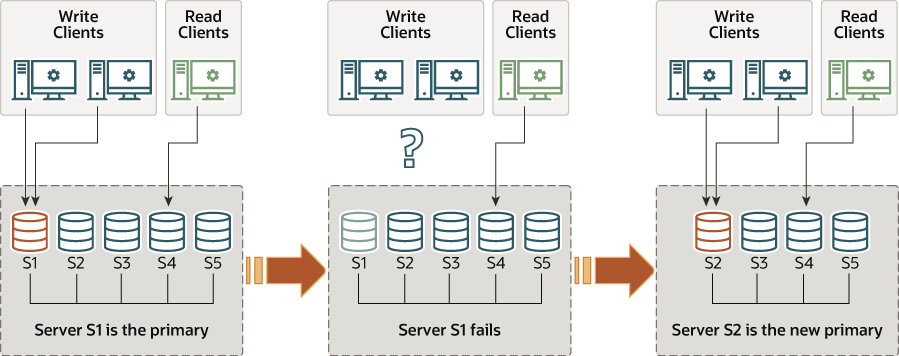In single-primary mode (group_replication_single_primary_mode=ON) the group has a single primary server that is set to read-write mode. All the other members in the group are set to read-only mode (with super_read_only=ON). The primary is typically the first server to bootstrap the group. All other servers that join the group learn about the primary server and are automatically set to read-only mode.
In single-primary mode, Group Replication enforces that only a single server writes to the group, so compared to multi-primary mode, consistency checking can be less strict and DDL statements do not need to be handled with any extra care. The option group_replication_enforce_update_everywhere_checks enables or disables strict consistency checks for a group. When deploying in single-primary mode, or changing the group to single-primary mode, this system variable must be set to OFF.
The member that is designated as the primary server can change in the following ways:
If the existing primary leaves the group, whether voluntarily or unexpectedly, a new primary is elected automatically.
You can appoint a specific member as the new primary using the
group_replication_set_as_primary()function.If you use the
group_replication_switch_to_single_primary_mode()function to change a group that was running in multi-primary mode to run in single-primary mode, a new primary is elected automatically, or you can appoint the new primary by specifying it with the function.
The functions can only be used when all group members are running MySQL 8.0.13 or higher. When a new primary server is elected automatically or appointed manually, it is automatically set to read-write, and the other group members remain as secondaries, and as such, read-only. Figure 18.4, “New Primary Election” shows this process.
When a new primary is elected or appointed, it might have a backlog of changes that had been applied on the old primary but have not yet been applied on this server. In this situation, until the new primary catches up with the old primary, read-write transactions might result in conflicts and be rolled back, and read-only transactions might result in stale reads. Group Replication's flow control mechanism, which minimizes the difference between fast and slow members, reduces the chances of this happening if it is activated and properly tuned. For more information on flow control, see Section 18.7.2, “Flow Control”. From MySQL 8.0.14, you can also use the group_replication_consistency system variable to configure the group's level of transaction consistency to prevent this issue. The setting BEFORE_ON_PRIMARY_FAILOVER (or any higher consistency level) holds new transactions on a newly elected primary until the backlog has been applied. For more information on transaction consistency, see Section 18.5.2, “Transaction Consistency Guarantees”. If flow control and transaction consistency guarantees are not used for a group, it is a good practice to wait for the new primary to apply its replication-related relay log before re-routing client applications to it.
